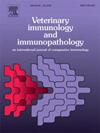口蹄疫病毒O型、A型、亚洲1型和sat2型疫苗结构蛋白抗体血清检测方法的比较评价
IF 1.4
3区 农林科学
Q4 IMMUNOLOGY
引用次数: 0
摘要
疫苗接种是控制和预防口蹄疫最有效的策略。其有效性可能受到疫苗配方、疫苗效力、疫苗接种策略和流行变种等因素的影响,这些因素可能导致疫苗需求及其控制的变化。检测结构蛋白抗体的血清学试验,如病毒中和试验(VNT)和结构蛋白elisa,被广泛用于监测疫苗的有效性。总体而言,需要血清型特异性检测,其中应包括能够检测特定血清型内所有变异的抗原,特别是疫苗中包含的那些抗原。本研究评估了四种商用ELISA试剂盒检测接种牛和猪口蹄疫病毒特异性抗体反应的性能。将ELISA结果与作为参考标准的VNT进行比较。共分析了417份牛血清样本和189份猪血清样本,这些样本来自接种了各种配方的动物,其中包括O1 Campos、A24 Cruzeiro、A2001、Asia 1 2015和sat2 2015菌株,以及来自未接种疫苗动物的50份牛血清和47份猪血清。对4170项试验的分析显示,受宿主物种和血清型的影响,不同测试格式的ELISA敏感性不同。通过Cohen ' s kappa系数测量,试剂盒表现出令人满意的性能和与VNT的强相关性,被确定为VNT的潜在替代品。正如预期的那样,用与疫苗株同源的抗原进行的测试表明与VNT几乎完全一致。然而,一些使用异种或可能是异种抗原的试剂盒也表现出非常好的性能,kappa值表明与VNT几乎完全一致。所有检测结果均显示出高特异性,这为通过调整截止值来提高低灵敏度试剂盒的性能提供了可能。它强调了使用经过适当验证的试剂盒的相关性,以确保能够识别使用中的疫苗产生的抗体。本文章由计算机程序翻译,如有差异,请以英文原文为准。
Comparative evaluation of serological assays for detecting antibodies against structural proteins elicited by foot-and-mouth disease virus vaccines of serotypes O, A, Asia 1 and SAT 2
Vaccination is the most effective strategy to control and prevent foot-and-mouth disease (FMD). Its effectiveness may be influenced by factors like vaccine formulation, vaccine potency, vaccination strategies, and by circulating variants, which may lead to changes in vaccine requirements and in their control. Serological assays detecting antibodies against structural proteins, such as virus neutralization test (VNT) and structural-protein ELISAs, are widely used to monitor vaccine effectiveness. In overall, serotype-specific tests are required, which should include antigens capable of detecting all variants within a given serotype, particularly those included in the vaccines. This study evaluates the performance of four commercial ELISA kits to detect FMD virus-specific antibody responses in vaccinated cattle and pigs. ELISA results were compared to VNT considered the reference standard. A total of 417 cattle and 189 pig serum samples from animals vaccinated with various formulations, containing O1 Campos, A24 Cruzeiro, A2001, Asia 1 2015 and SAT 2 2015 strains, were analyzed, along with 50 bovine and 47 pig sera from unvaccinated animals. Analysis of 4170 assays revealed varying ELISA sensitivities across different test formats, influenced by both host species and serotype. Kits demonstrating satisfactory performance and strong correlation with VNT, as measured by Cohen´s kappa coefficient, were identified as potential alternatives to VNT. As expected, tests with antigens homologous to the vaccine strain demonstrated almost perfect agreement with VNT. Nevertheless, some kits which use heterologous, or presumably heterologous, antigens also exhibited very good performances, with kappa values indicating almost perfect to substantial agreement with VNT. All assays showed high specificity, opening the possibility of improving the performance of low-sensitivity kits by adjusting cutoff values. It is highlighted the relevance of using kits with proper validation to ensure the ability to recognize antibodies generated by the vaccines in use.
求助全文
通过发布文献求助,成功后即可免费获取论文全文。
去求助
来源期刊
CiteScore
3.40
自引率
5.60%
发文量
79
审稿时长
70 days
期刊介绍:
The journal reports basic, comparative and clinical immunology as they pertain to the animal species designated here: livestock, poultry, and fish species that are major food animals and companion animals such as cats, dogs, horses and camels, and wildlife species that act as reservoirs for food, companion or human infectious diseases, or as models for human disease.
Rodent models of infectious diseases that are of importance in the animal species indicated above,when the disease requires a level of containment that is not readily available for larger animal experimentation (ABSL3), will be considered. Papers on rabbits, lizards, guinea pigs, badgers, armadillos, elephants, antelope, and buffalo will be reviewed if the research advances our fundamental understanding of immunology, or if they act as a reservoir of infectious disease for the primary animal species designated above, or for humans. Manuscripts employing other species will be reviewed if justified as fitting into the categories above.
The following topics are appropriate: biology of cells and mechanisms of the immune system, immunochemistry, immunodeficiencies, immunodiagnosis, immunogenetics, immunopathology, immunology of infectious disease and tumors, immunoprophylaxis including vaccine development and delivery, immunological aspects of pregnancy including passive immunity, autoimmuity, neuroimmunology, and transplanatation immunology. Manuscripts that describe new genes and development of tools such as monoclonal antibodies are also of interest when part of a larger biological study. Studies employing extracts or constituents (plant extracts, feed additives or microbiome) must be sufficiently defined to be reproduced in other laboratories and also provide evidence for possible mechanisms and not simply show an effect on the immune system.

 求助内容:
求助内容: 应助结果提醒方式:
应助结果提醒方式:


